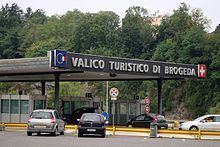 | ||
Don t comply at illegal internal checkpoints border checkpoint 60 miles from border
A border checkpoint is a place, generally between two countries, where travelers or goods are inspected. Authorization often is required to enter a country through its borders. Access-controlled borders often have a limited number of checkpoints where they can be crossed without legal sanctions. Arrangements or treaties may be formed to allow or mandate less restrained crossings (e.g. the Schengen Agreement). Land border checkpoints (land ports of entry) can be contrasted with the customs and immigration facilities at seaports, international airports, and other ports of entry.
Contents
- Don t comply at illegal internal checkpoints border checkpoint 60 miles from border
- Definitions in European Union Schengen law
- References
Checkpoints generally serve two purposes:
Checkpoints are usually manned by a uniformed service (sometimes referred to as customs service or border patrol agents).
In some countries (e.g. China and Japan), there are border checkpoints when both entering and exiting the country, while in others (e.g. U.S. and Canada), there are border checkpoints only when entering the country. (There are also United States Border Patrol interior checkpoints.)
Definitions in European Union (Schengen) law
The Schengen Borders Code, which forms part of the law of the European Union, defines some terms as follows (particularities with respect to the EU are left out, in order to emphasize general usability of those definitions):
These definitions mean that a place where a road crosses an internal Schengen border is legally not a "border crossing point".
